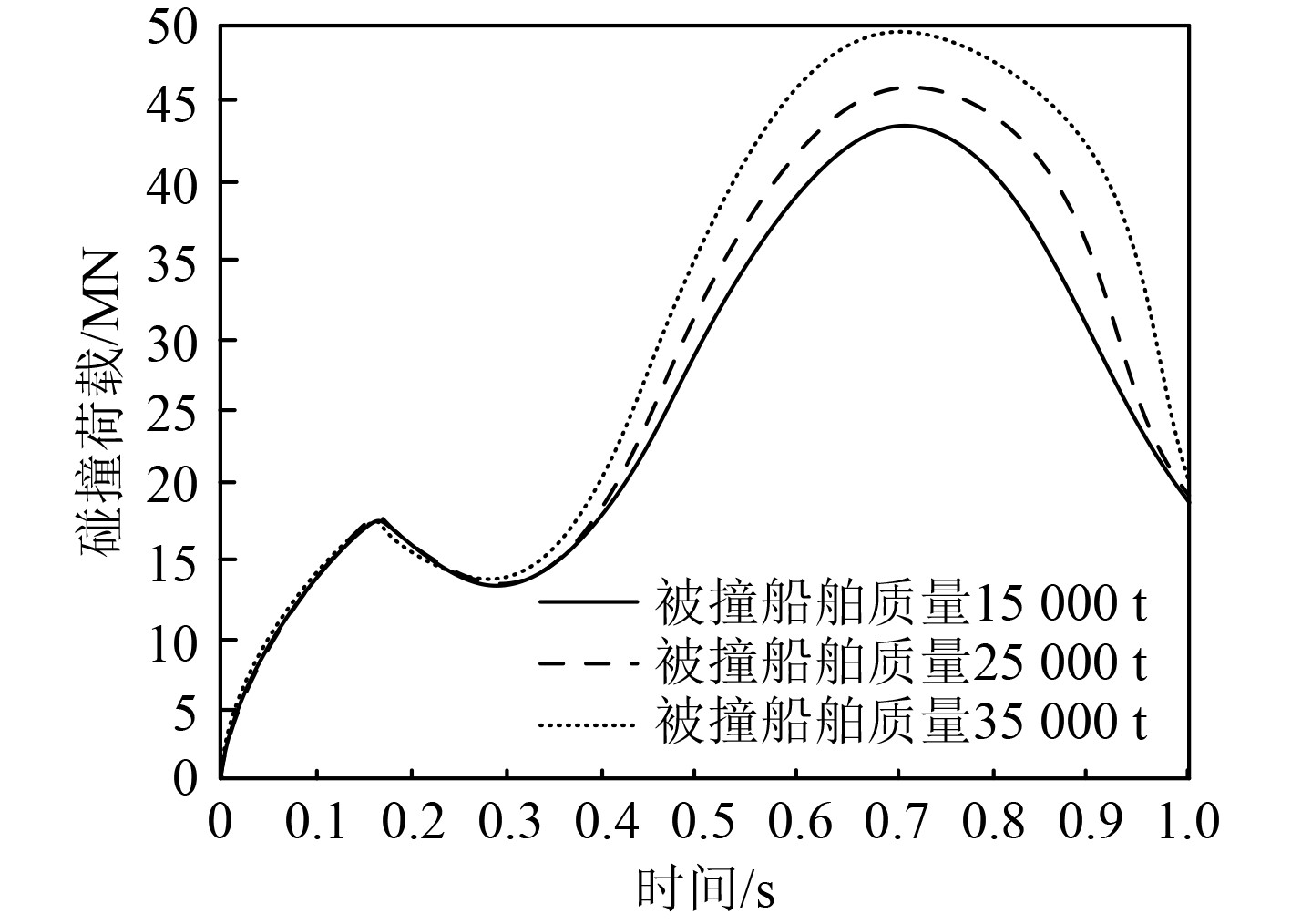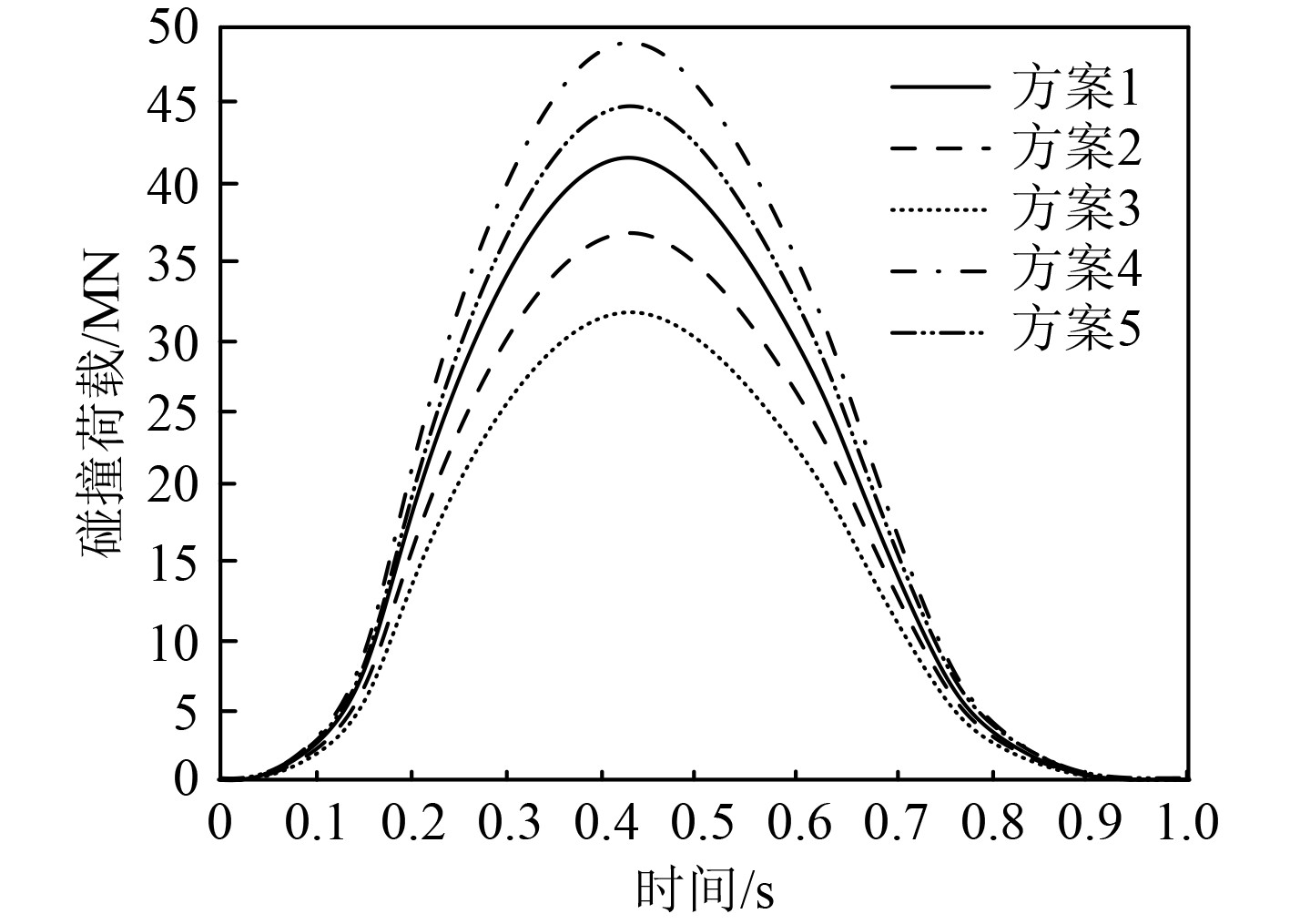2. 郑州工商学院,河南 郑州 450000
2. Zhengzhou Technology and Business University, Zhengzhou 450000, China
船舶碰撞属于较为严重的海洋事故。碰撞后,既会破坏船舶结构,还会污染海水[1],导致船舶航行安全受到影响,以及船员生命安全受到威胁[2]。为降低船舶碰撞导致的严重后果,研究船舶碰撞载荷数值计算方法,为设计抗撞性能更佳的船舶结构[3]提供参考。刘俊杰等[4]通过瞬态动力学分析程序,对船舶碰撞载荷实施数值模拟,经过实验分析认为碰撞位置与浮冰尺度均会对船舶碰撞载荷产生影响。童宗鹏等[5]利用有限元耦合方法,数值模拟分析船舶碰撞载荷,经过实验分析得知:冰层越厚,碰撞载荷越大,当冰层厚度为1.6 m时,船舶不会出现裂纹扩散情况,破坏面积较小。但这2种方法的数值模拟稳定性均较差,无法为船舶碰撞载荷分析提供稳定可靠的数据支持。精细积分法通过添加对偶变量,降阶处理动力学方程,通过指数函数的精细算法,求解降阶后的动力学方程,获取精准的计算结果[6-8]。精细积分法计算准确性高、稳定性强,在线性与非线性动力分析中均有较优的应用效果。为此,研究应用精细积分的船舶碰撞载荷数值计算方法,提升载荷数值计算稳定性。
1 被撞船舶结构参数为分析船舶碰撞载荷情况,选择3种不同质量的船舶作为试验对象,被撞船舶的具体结构参数如表1所示。
|
|
表 1 被撞船舶结构参数 Tab.1 Structural parameters of the collided ship |
在3种不同类型的船舶外部均安装一个防护装置,用于提升船舶的防撞性能,防护装置内包含橡胶、泡沫铝与钢壳3层材料,利用精细积分法计算不同泡沫铝与橡胶厚度时碰撞载荷数值,分析不同泡沫铝与橡胶厚度时的防撞性能。
以质量为15000 t的船舶为例,不同防护装置方案如表2所示。
|
|
表 2 不同防护装置方案 Tab.2 Scheme of different protective devices |
针对碰撞过程,依据船舶基本参数,建立碰撞的运动方程,公式如下:
| $ S\ddot x\left( t \right) + C\dot x\left( t \right) + Kx\left( t \right) = Df\left( t \right) 。$ | (1) |
式中:x(t)为被撞船舶的广义位移向量;
为便于计算,对式(1)展开降阶,并添加对偶向量
| $ \dot x\left( t \right) = - \frac{{{S^{ - 1}}Cx\left( t \right)}}{2} + {M^{ - 1}}p。$ | (2) |
微分处理
| $ \dot p = \left( {\frac{{C{M^{ - 1}}C}}{4}} \right)x\left( t \right) - \frac{{C{M^{ - 1}}p}}{2} - Df\left( t \right),$ | (3) |
其中,
整理式(2)与式(3),得到:
| $ \dot Z = GZ\left( t \right) + Bf\left( t \right)。$ | (4) |
其中:
式(4)属于碰撞问题的状态传递方程,式(4)的一般解为:
| $ Z\left( t \right) = {e^{\left( {Gt} \right)}}Z\left( 0 \right) + \int_0^t {{e^{G\left( {t - \tau } \right)}}Bf\left( \tau \right){\rm{d}}\tau }。$ | (5) |
其中:
离散碰撞载荷,获取步长为
| $ \begin{split} & Z\left( {{t_k}} \right) = {e^{\left( {G{t_k}} \right)}}Z\left( 0 \right) + \int_0^{{t_k}} {{e^{G\left( {{t_k} - \tau } \right)}}} Bf\left( \tau \right){\rm{d}}\tau,\\ & Z\left( {{t_{k + 1}}} \right) = {e^{\left( {G\Delta t} \right)}}Z\left( {{t_k}} \right) + \int_{{t_k}}^{{t_{k + 1}}} {{e^{G\left( {{t_{k + 1}} - \tau } \right)}}} Bf\left( \tau \right){\rm{d}}\tau 。\end{split} $ | (6) |
令指数矩阵是
| $ \begin{split} Z\left( {{t_{k + 1}}} \right) =& R\left( {\Delta t} \right)Z\left( {{t_k}} \right) + \int_{{t_k}}^{{t_{k + 1}}} {{e^{G\left( {{t_{k + 1}} - \tau } \right)}}Bf\left( \tau \right){\rm{d}}\tau } = \\ & R\left( {\Delta t} \right) \cdot \left( Z\left( {{t_k}} \right) + {G^{ - 1}}\left( {Bf\left( {{t_k}} \right)} \right) + {G^{ - 1}} \times \right.\\ &\left.\frac{{Bf\left( {{t_{k + 1}}} \right) - Bf\left( {{t_k}} \right)}}{{\Delta t}} \right)- \\ & {G^{ - 1}}\left( {{G^{ - 1}}\frac{{Bf\left( {{t_{k + 1}}} \right) - Bf\left( {{t_k}} \right)}}{{\Delta t}} + Bf\left( {{t_{k + 1}}} \right)} \right)。\\ \end{split} $ | (7) |
| $ R\left( {\Delta t} \right) = {e^{G\Delta t}} = {\left( {{e^{G\frac{{\Delta t}}{{{2^N}}}}}} \right)^{{2^N}}} = {\left( {{e^{G\tau }}} \right)^{{2^N}}} 。$ | (8) |
其中:
展开
| $ \begin{split} & R\left( \tau \right) = {e^{G\tau }} = I + {R_a} ,\\ &{R_a} = G\tau + \frac{{{{\left( {G\tau } \right)}^2}}}{{2!}} + \frac{{{{\left( {G\tau } \right)}^3}}}{{3!}} + \cdots + \frac{{{{\left( {G\tau } \right)}^l}}}{{l!}}。\end{split} $ | (9) |
其中,
为提升船舶碰撞载荷数值计算精度,变更
| $ {\left( {{R_a}} \right)_{i + 1}} = 2{\left( {{R_a}} \right)_i} + {\left( {{R_a}} \right)_i} \times {\left( {{R_a}} \right)_i} ,$ | (10) |
其中,时间间隔编号为
通过式(10)可获取
| $ R\left( {\Delta t} \right) = I + {\left( {{R_a}} \right)_N}。$ | (11) |
通过式(11)可计算获取
以被撞船舶质是15000 t,碰撞角度60°,防护装置方案1为例,利用精细积分法,计算不同被撞船舶航行速度时,横纵方向上船舶的碰撞载荷数值,分析船舶的防撞性能,计算结果如图1所示。

|
图 1 船舶碰撞载荷数值计算结果 Fig. 1 Numerical calculation results of ship collision load |
根据图1(a)可知,随着被撞船舶速度的提升,在垂直方向上,首个碰撞载荷峰值越来越小,第二个碰撞载荷峰值越来越大;根据图1(b)可知,在水平方向,被撞船速度越快,碰撞载荷的数值越大。综合分析可知,被撞船速度越快,碰撞载荷数值越大,船舶外壳破裂速度也随之加快。
2.2 不同船舶质量时碰撞载荷数值计算结果以被撞船舶航行速度1 m/s,碰撞角度60°,防护装置方案1为例,利用精细积分法,计算不同被撞船舶质量时的碰撞载荷数值,分析船舶的防撞性能。因为碰撞载荷在垂直方向上的变化较为明显,所以后续试验仅分析不同被撞船舶质量时,垂直方向上的碰撞载荷数值,计算结果如图2所示。

|
图 2 不同船舶质量时的碰撞载荷数值计算结果 Fig. 2 Numerical calculation results of collision load with different ship masses |
可知,随着被撞船舶质量的提升,碰撞前期,3种类型被撞船舶质量的载荷数值相差较小,当时间超过0.4 s左右时,3种类型被撞船舶质量的载荷数值差距开始变大,被撞船舶质量越大,碰撞载荷数值越大。试验证明:碰撞前期,不同被撞船舶质量时的碰撞载荷数值非常接近,碰撞后期,不同被撞船舶质量时的碰撞载荷数值间的差距不断变大,被撞船舶质量越大,碰撞载荷数值越大。
2.3 不同防护装置方案时船舶碰撞载荷数值计算结果以被撞船舶质量15000 t,被撞船舶航行速度1 m/s,碰撞角度60°为例,利用精细积分法,计算不同防护装置方案时船舶可承受的碰撞载荷数值,分析船舶的防撞性能,计算结果如图3所示。

|
图 3 不同防护装置方案时的碰撞载荷数值 Fig. 3 Impact load values under different protective device schemes |
可知:当碰撞时间在0.4 s左右时,不同防护装置方案下,船舶碰撞载荷均达到峰值;当橡胶厚度一致时,泡沫铝越厚,船舶可承受碰撞载荷数值越大;当泡沫铝厚度一致时,橡胶厚度越厚,船舶可承受碰撞载荷数值越大;船舶碰撞载荷数值的最大值是方案4,即泡沫铝厚度为3 m与橡胶厚度为3 m时的防护装置抗撞性能最佳。试验证明,随着泡沫铝厚度与橡胶厚度的增加,船舶碰撞载荷数值越来越大,船舶防护装置的防撞性能越佳。
3 结 语船舶航行速度不断提升,导致船舶航行过程中出现碰撞事故的概率也不断增加。为避免碰撞破坏船舶结构,影响其航行的安全性,研究应用精细积分的船舶碰撞载荷数值计算方法。研究结果表明:船舶航行速度与船舶质量,均会影响船舶碰撞载荷数值;提升被撞船舶航行速度与质量,均会提升船舶碰撞载荷数值,加快船舶外壳破裂速度。
| [1] |
王少博, 张英俊, 胡鑫. 考虑船位预测不确定性的船舶碰撞危险度计算方法[J]. 中国舰船研究, 2021, 16(1): 114-120. WANG Shaobo, ZHANG Yingjun, HU Xin. Ship collision risk calculation method considering uncertainty of ship position prediction[J]. Chinese Journal of Ship Research, 2021, 16(1): 114-120. |
| [2] |
杨鹏, 寇冠元, 朱学康, 等. 浮体浅水波浪载荷数值计算方法研究[J]. 中国舰船研究, 2019, 14(1): 19-26. YANG Peng, KOU Guanyuan, ZHU Xuekang, et al. Numerical calculation method for wave loads of floating structures in shallow water[J]. Chinese Journal of Ship Research, 2019, 14(1): 19-26. |
| [3] |
闫晋辉, 任鸿, 王琳. 船体结构在预载荷作用下的瞬态响应分析[J]. 船海工程, 2019, 48(6): 16-19. YAN Jinhui, REN Hong, WANG Lin. Transient Response Analysis of Ship Structures under Preload[J]. Ship & Ocean Engineering, 2019, 48(6): 16-19. |
| [4] |
刘俊杰, 夏劲松, 金言, 等. 冰-水耦合作用下船舶与浮冰碰撞动响应数值仿真研究[J]. 船舶力学, 2020, 24(5): 651-661. LIU Junjie, XIA Jingsong, JIN Yan, et al. Numerical simulation of dynamic response of collision between ship and floating ice under ice-water coupling effect[J]. Journal of Ship Mechanics, 2020, 24(5): 651-661. DOI:10.3969/j.issn.1007-7294.2020.05.011 |
| [5] |
童宗鹏, 叶林昌, 夏兆旺, 等. 基于海冰JH-2模型的极地邮轮冰-船碰撞性能模拟分析[J]. 中国舰船研究, 2021, 16(5): 87-94. TONG Zongpeng, YE Linchang, XIA Zhaowang, et al. Simulation analysis on collision performance of polar cruise vessel based on JH-2 sea ice model[J]. Chinese Journal of Ship Research, 2021, 16(5): 87-94. |
| [6] |
杨永, 李海滨. 基于对偶神经网络的动力方程精细积分法[J]. 振动与冲击, 2022, 41(16): 188-193. YANG Yong, LI Haibin. A precise integration method for dynamic equations based on dual neural networks[J]. Journal of Vibration and Shock, 2022, 41(16): 188-193. |
| [7] |
刘冬兵, 王永, 李博文, 等. 非线性动力方程的一种改进精细积分单步方法[J]. 振动与冲击, 2022, 41(5): 182-188. LIU Dongbing, WANG Yong, LI Bowen, et al. An improved precise integration single-step method for nonlinear dynamic equations[J]. Journal of Vibration and Shock, 2022, 41(5): 182-188. |
| [8] |
王海波, 纪海潮. 非线性动力方程精细积分法的自适应步长研究[J]. 计算力学学报, 2021, 38(3): 371-376. WANG Haibo, JI Haichao. Study on adaptive step size of precise intrgration method for nonlinear dynamic equations[J]. Chinese Journal of Computational Mechanics, 2021, 38(3): 371-376. |
 2023, Vol. 45
2023, Vol. 45
